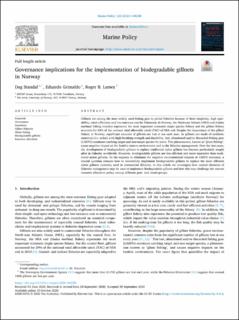| dc.contributor.author | Standal, Dag | |
| dc.contributor.author | Grimaldo, Eduardo | |
| dc.contributor.author | Larsen, Roger B. | |
| dc.date.accessioned | 2021-10-06T12:07:26Z | |
| dc.date.available | 2021-10-06T12:07:26Z | |
| dc.date.created | 2020-11-04T15:19:54Z | |
| dc.date.issued | 2020 | |
| dc.identifier.citation | Marine Policy. 2020, 122 . | en_US |
| dc.identifier.issn | 0308-597X | |
| dc.identifier.uri | https://hdl.handle.net/11250/2788136 | |
| dc.description.abstract | Gillnets are among the most widely used fishing gear in global fisheries because of their simplicity, high operability, catch efficiency and low entrance cost for fishermen. In Norway, the Northeast Atlantic (NEA) cod (Gadus morhua) fishing industry represents the most important economic single species fishery and the gillnet fishery accounts for 24% of the national total allowable catch (TAC) of NEA cod. Despite the importance of the gillnet fishery in Norway, significant amounts of gillnets are lost at sea each year. As gillnets are made of synthetic materials (i.e. nylon) with high breaking strength and durability, lost, abandoned and/or discarded fishing gear (LADFG) continues catching target and non-target species for years. This phenomenon, known as "ghost fishing", cause negative impact on the benthic marine environment and to the fisheries management. Over the last years, the development of biodegradable gillnets to replace traditional nylon gillnets has become particularly sought after in fisheries worldwide. However, biodegradable gillnets are less efficient and more expensive than traditional nylon gillnets. As the urgency to eliminate the negative environmental impacts of LADFG increases, a crucial question remains how to successfully implement biodegradable gillnets to replace the more efficient nylon gillnets currently used in commercial fisheries. In this article we investigate how central elements of fisheries management may be used to implement biodegradable gillnets and how this may challenge the current resource allocation policy among different gear- and vessel groups. | en_US |
| dc.language.iso | eng | en_US |
| dc.publisher | Elsevier | en_US |
| dc.rights | Navngivelse 4.0 Internasjonal | * |
| dc.rights.uri | http://creativecommons.org/licenses/by/4.0/deed.no | * |
| dc.subject | Resource allocation | en_US |
| dc.subject | Biodegradable gillnets | en_US |
| dc.subject | Ghost fishing | en_US |
| dc.subject | Gillnet fisheries | en_US |
| dc.subject | Incentives | en_US |
| dc.subject | Governance | en_US |
| dc.title | Governance implications for the implementation of biodegradable gillnets in Norway | en_US |
| dc.type | Peer reviewed | en_US |
| dc.type | Journal article | en_US |
| dc.description.version | publishedVersion | en_US |
| dc.rights.holder | © 2020 The Author(s). Published by Elsevier Ltd. This is an open access article under the CC BY license | en_US |
| dc.source.pagenumber | 9 | en_US |
| dc.source.volume | 122 | en_US |
| dc.source.journal | Marine Policy | en_US |
| dc.identifier.doi | 10.1016/j.marpol.2020.104238 | |
| dc.identifier.cristin | 1844968 | |
| dc.source.articlenumber | 104238 | en_US |
| cristin.ispublished | true | |
| cristin.fulltext | original | |
| cristin.qualitycode | 1 | |

